Analysis of Strategic Issues in Project Management - Report
VerifiedAdded on 2023/06/10
|7
|1521
|102
Report
AI Summary
This report delves into strategic issues within project management, focusing on two primary areas: value stream mapping (VSM) and benchmarking. The VSM section emphasizes the importance of defining the client and eliminating waste based on lean principles. It explains how VSM helps identify and remove non-value-added activities, leading to improved efficiency and client satisfaction. The report provides a practical example from the service industry, illustrating the application of VSM in a college exmatriculation process. The benchmarking section discusses the significance of benchmarking for achieving competitive advantage, innovation, and productivity. It defines benchmarking as the search for best practices and outlines various types of benchmarking, including process, financial, performance, product, strategic, functional, best-in-class, operations, and energy benchmarking. The report highlights the benefits of benchmarking, such as cost savings and improved learning, while also mentioning methods for enhanced performance and improved learning within an organization. The report concludes by referencing relevant books and journal articles that support the concepts discussed.
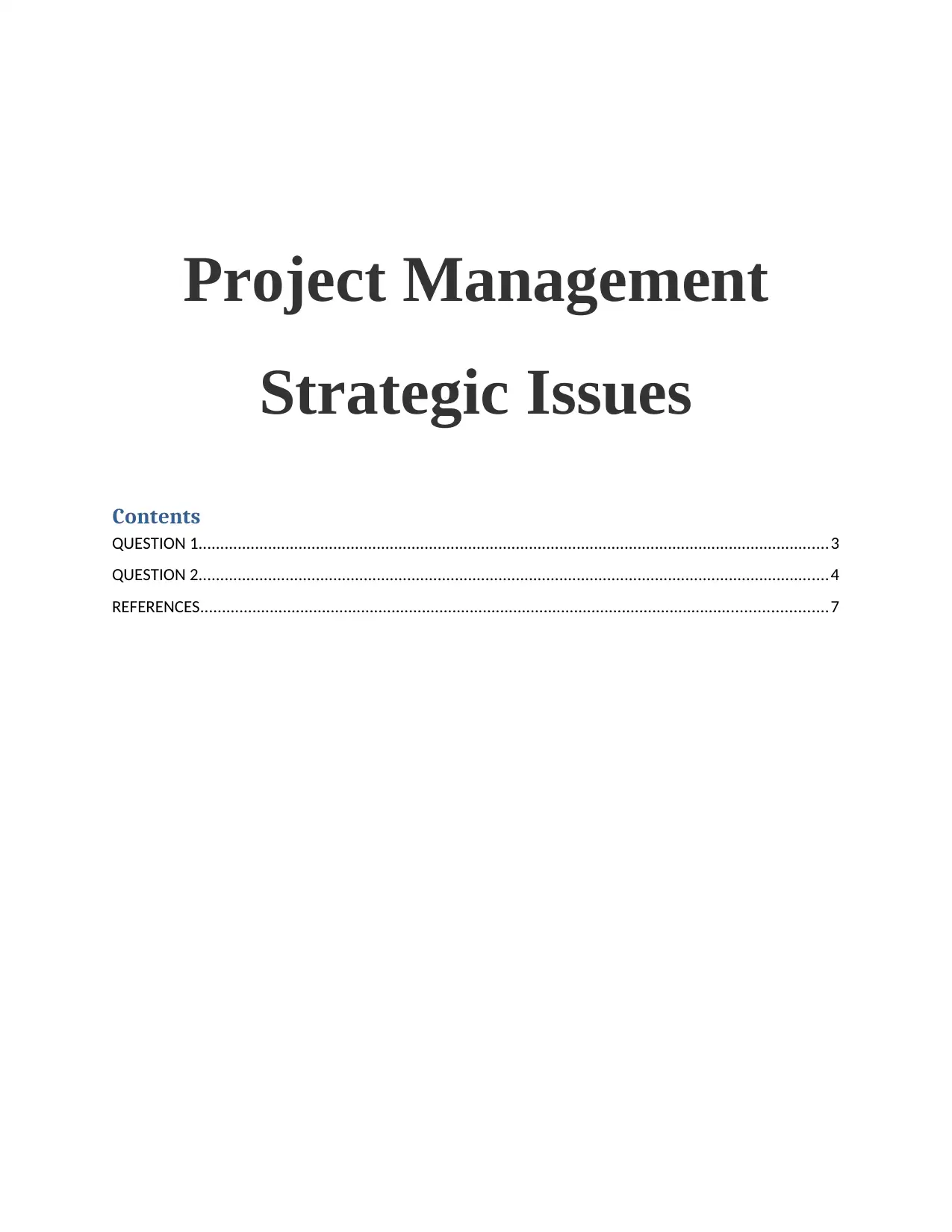
Project Management
Strategic Issues
Contents
QUESTION 1.................................................................................................................................................3
QUESTION 2.................................................................................................................................................4
REFERENCES................................................................................................................................................7
Strategic Issues
Contents
QUESTION 1.................................................................................................................................................3
QUESTION 2.................................................................................................................................................4
REFERENCES................................................................................................................................................7
Paraphrase This Document
Need a fresh take? Get an instant paraphrase of this document with our AI Paraphraser

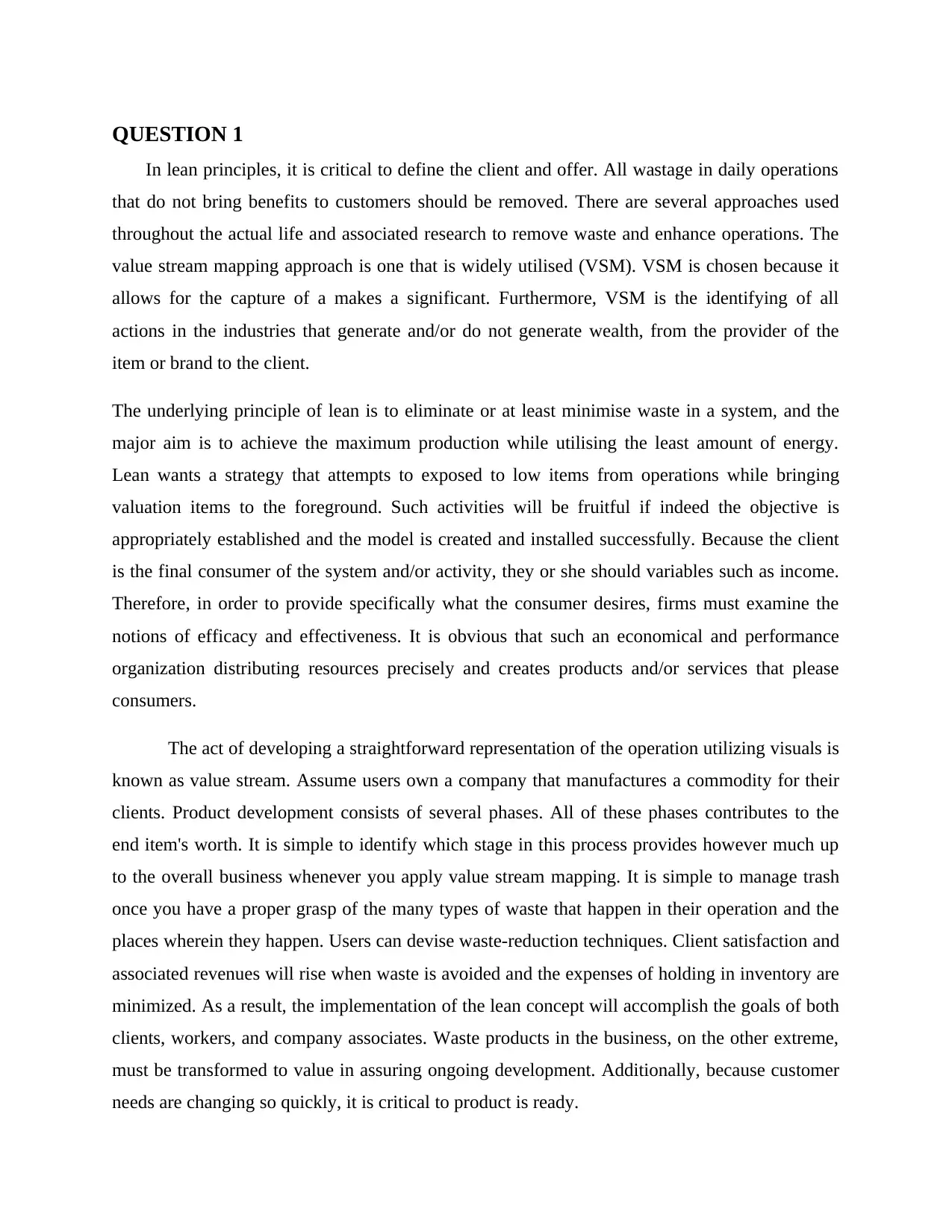
QUESTION 1
In lean principles, it is critical to define the client and offer. All wastage in daily operations
that do not bring benefits to customers should be removed. There are several approaches used
throughout the actual life and associated research to remove waste and enhance operations. The
value stream mapping approach is one that is widely utilised (VSM). VSM is chosen because it
allows for the capture of a makes a significant. Furthermore, VSM is the identifying of all
actions in the industries that generate and/or do not generate wealth, from the provider of the
item or brand to the client.
The underlying principle of lean is to eliminate or at least minimise waste in a system, and the
major aim is to achieve the maximum production while utilising the least amount of energy.
Lean wants a strategy that attempts to exposed to low items from operations while bringing
valuation items to the foreground. Such activities will be fruitful if indeed the objective is
appropriately established and the model is created and installed successfully. Because the client
is the final consumer of the system and/or activity, they or she should variables such as income.
Therefore, in order to provide specifically what the consumer desires, firms must examine the
notions of efficacy and effectiveness. It is obvious that such an economical and performance
organization distributing resources precisely and creates products and/or services that please
consumers.
The act of developing a straightforward representation of the operation utilizing visuals is
known as value stream. Assume users own a company that manufactures a commodity for their
clients. Product development consists of several phases. All of these phases contributes to the
end item's worth. It is simple to identify which stage in this process provides however much up
to the overall business whenever you apply value stream mapping. It is simple to manage trash
once you have a proper grasp of the many types of waste that happen in their operation and the
places wherein they happen. Users can devise waste-reduction techniques. Client satisfaction and
associated revenues will rise when waste is avoided and the expenses of holding in inventory are
minimized. As a result, the implementation of the lean concept will accomplish the goals of both
clients, workers, and company associates. Waste products in the business, on the other extreme,
must be transformed to value in assuring ongoing development. Additionally, because customer
needs are changing so quickly, it is critical to product is ready.
In lean principles, it is critical to define the client and offer. All wastage in daily operations
that do not bring benefits to customers should be removed. There are several approaches used
throughout the actual life and associated research to remove waste and enhance operations. The
value stream mapping approach is one that is widely utilised (VSM). VSM is chosen because it
allows for the capture of a makes a significant. Furthermore, VSM is the identifying of all
actions in the industries that generate and/or do not generate wealth, from the provider of the
item or brand to the client.
The underlying principle of lean is to eliminate or at least minimise waste in a system, and the
major aim is to achieve the maximum production while utilising the least amount of energy.
Lean wants a strategy that attempts to exposed to low items from operations while bringing
valuation items to the foreground. Such activities will be fruitful if indeed the objective is
appropriately established and the model is created and installed successfully. Because the client
is the final consumer of the system and/or activity, they or she should variables such as income.
Therefore, in order to provide specifically what the consumer desires, firms must examine the
notions of efficacy and effectiveness. It is obvious that such an economical and performance
organization distributing resources precisely and creates products and/or services that please
consumers.
The act of developing a straightforward representation of the operation utilizing visuals is
known as value stream. Assume users own a company that manufactures a commodity for their
clients. Product development consists of several phases. All of these phases contributes to the
end item's worth. It is simple to identify which stage in this process provides however much up
to the overall business whenever you apply value stream mapping. It is simple to manage trash
once you have a proper grasp of the many types of waste that happen in their operation and the
places wherein they happen. Users can devise waste-reduction techniques. Client satisfaction and
associated revenues will rise when waste is avoided and the expenses of holding in inventory are
minimized. As a result, the implementation of the lean concept will accomplish the goals of both
clients, workers, and company associates. Waste products in the business, on the other extreme,
must be transformed to value in assuring ongoing development. Additionally, because customer
needs are changing so quickly, it is critical to product is ready.
⊘ This is a preview!⊘
Do you want full access?
Subscribe today to unlock all pages.

Trusted by 1+ million students worldwide
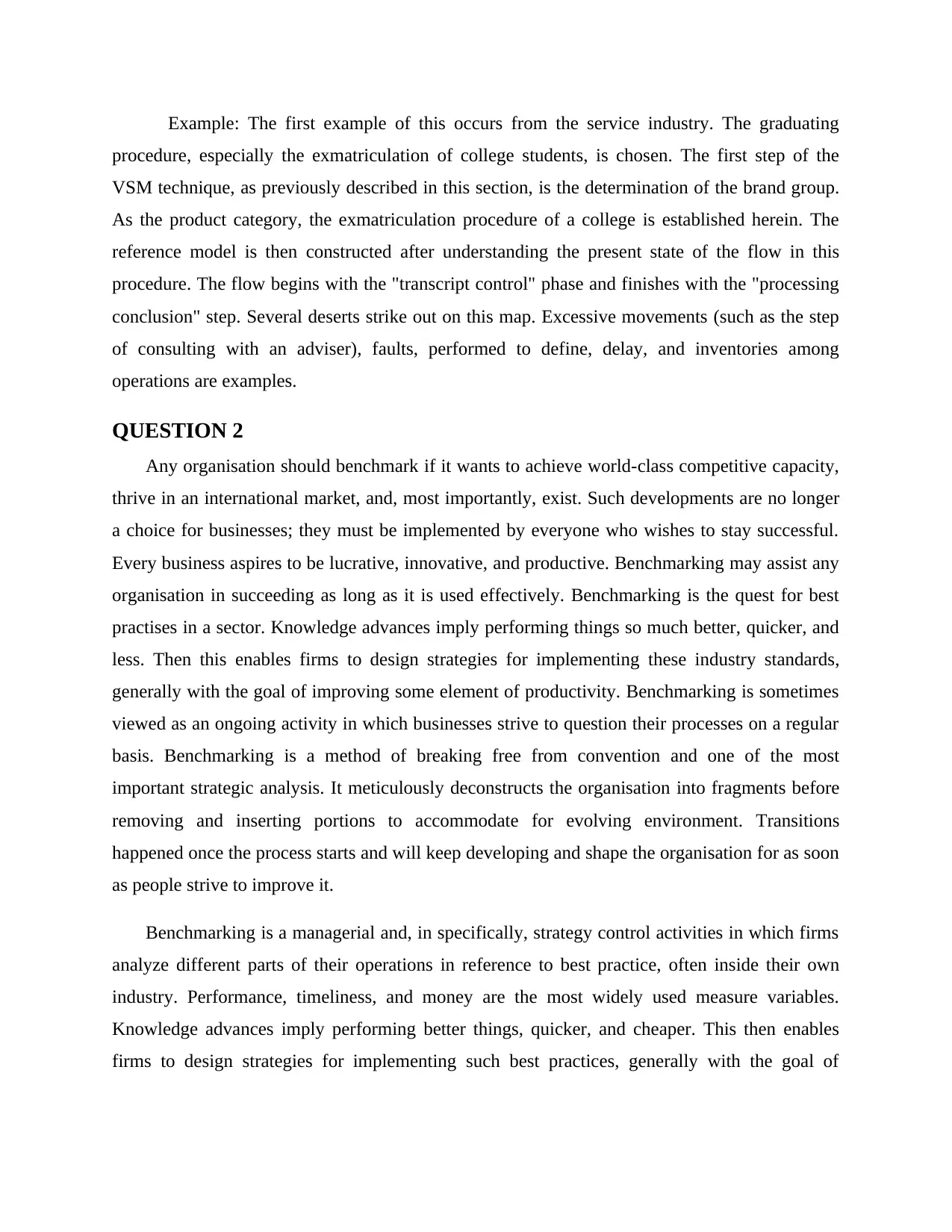
Example: The first example of this occurs from the service industry. The graduating
procedure, especially the exmatriculation of college students, is chosen. The first step of the
VSM technique, as previously described in this section, is the determination of the brand group.
As the product category, the exmatriculation procedure of a college is established herein. The
reference model is then constructed after understanding the present state of the flow in this
procedure. The flow begins with the "transcript control" phase and finishes with the "processing
conclusion" step. Several deserts strike out on this map. Excessive movements (such as the step
of consulting with an adviser), faults, performed to define, delay, and inventories among
operations are examples.
QUESTION 2
Any organisation should benchmark if it wants to achieve world-class competitive capacity,
thrive in an international market, and, most importantly, exist. Such developments are no longer
a choice for businesses; they must be implemented by everyone who wishes to stay successful.
Every business aspires to be lucrative, innovative, and productive. Benchmarking may assist any
organisation in succeeding as long as it is used effectively. Benchmarking is the quest for best
practises in a sector. Knowledge advances imply performing things so much better, quicker, and
less. Then this enables firms to design strategies for implementing these industry standards,
generally with the goal of improving some element of productivity. Benchmarking is sometimes
viewed as an ongoing activity in which businesses strive to question their processes on a regular
basis. Benchmarking is a method of breaking free from convention and one of the most
important strategic analysis. It meticulously deconstructs the organisation into fragments before
removing and inserting portions to accommodate for evolving environment. Transitions
happened once the process starts and will keep developing and shape the organisation for as soon
as people strive to improve it.
Benchmarking is a managerial and, in specifically, strategy control activities in which firms
analyze different parts of their operations in reference to best practice, often inside their own
industry. Performance, timeliness, and money are the most widely used measure variables.
Knowledge advances imply performing better things, quicker, and cheaper. This then enables
firms to design strategies for implementing such best practices, generally with the goal of
procedure, especially the exmatriculation of college students, is chosen. The first step of the
VSM technique, as previously described in this section, is the determination of the brand group.
As the product category, the exmatriculation procedure of a college is established herein. The
reference model is then constructed after understanding the present state of the flow in this
procedure. The flow begins with the "transcript control" phase and finishes with the "processing
conclusion" step. Several deserts strike out on this map. Excessive movements (such as the step
of consulting with an adviser), faults, performed to define, delay, and inventories among
operations are examples.
QUESTION 2
Any organisation should benchmark if it wants to achieve world-class competitive capacity,
thrive in an international market, and, most importantly, exist. Such developments are no longer
a choice for businesses; they must be implemented by everyone who wishes to stay successful.
Every business aspires to be lucrative, innovative, and productive. Benchmarking may assist any
organisation in succeeding as long as it is used effectively. Benchmarking is the quest for best
practises in a sector. Knowledge advances imply performing things so much better, quicker, and
less. Then this enables firms to design strategies for implementing these industry standards,
generally with the goal of improving some element of productivity. Benchmarking is sometimes
viewed as an ongoing activity in which businesses strive to question their processes on a regular
basis. Benchmarking is a method of breaking free from convention and one of the most
important strategic analysis. It meticulously deconstructs the organisation into fragments before
removing and inserting portions to accommodate for evolving environment. Transitions
happened once the process starts and will keep developing and shape the organisation for as soon
as people strive to improve it.
Benchmarking is a managerial and, in specifically, strategy control activities in which firms
analyze different parts of their operations in reference to best practice, often inside their own
industry. Performance, timeliness, and money are the most widely used measure variables.
Knowledge advances imply performing better things, quicker, and cheaper. This then enables
firms to design strategies for implementing such best practices, generally with the goal of
Paraphrase This Document
Need a fresh take? Get an instant paraphrase of this document with our AI Paraphraser
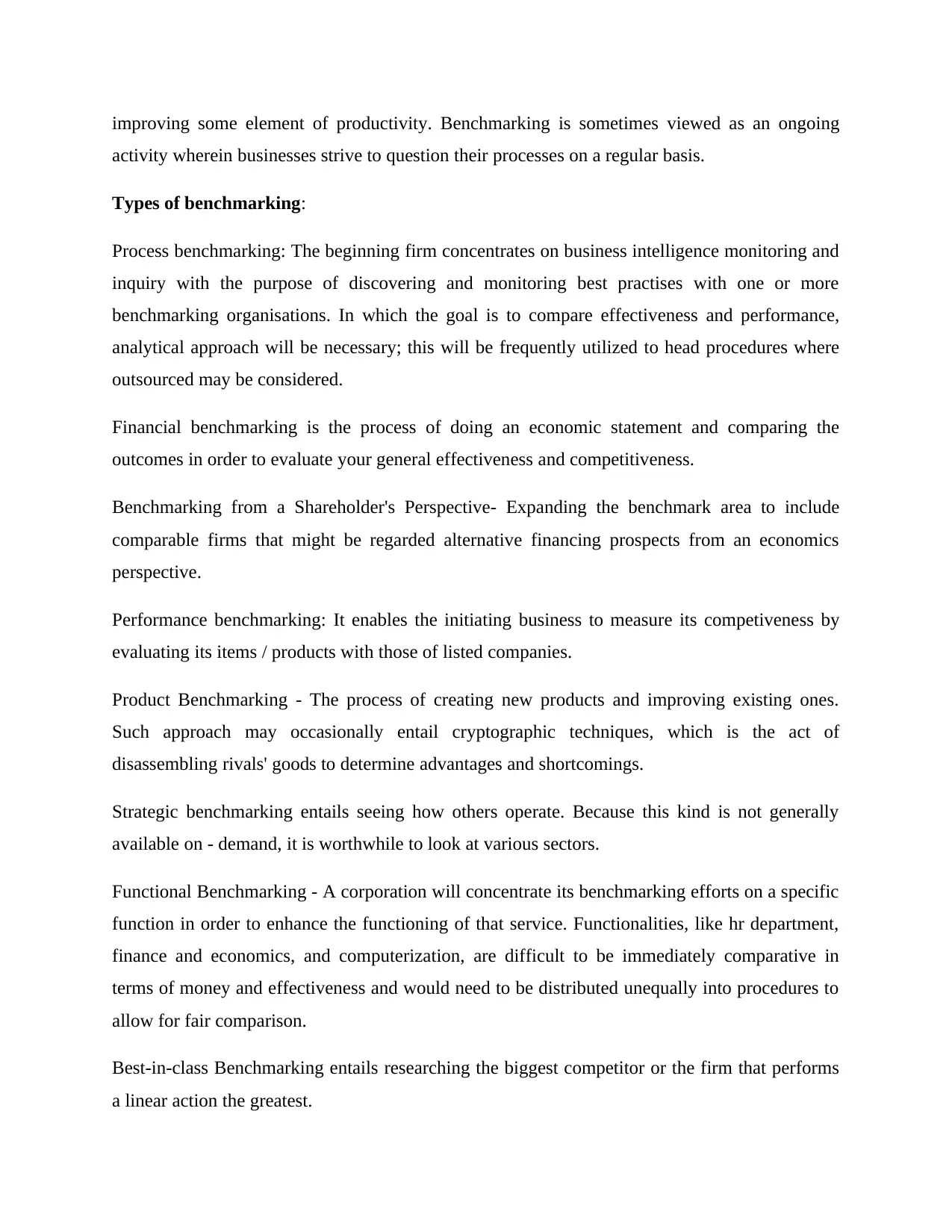
improving some element of productivity. Benchmarking is sometimes viewed as an ongoing
activity wherein businesses strive to question their processes on a regular basis.
Types of benchmarking:
Process benchmarking: The beginning firm concentrates on business intelligence monitoring and
inquiry with the purpose of discovering and monitoring best practises with one or more
benchmarking organisations. In which the goal is to compare effectiveness and performance,
analytical approach will be necessary; this will be frequently utilized to head procedures where
outsourced may be considered.
Financial benchmarking is the process of doing an economic statement and comparing the
outcomes in order to evaluate your general effectiveness and competitiveness.
Benchmarking from a Shareholder's Perspective- Expanding the benchmark area to include
comparable firms that might be regarded alternative financing prospects from an economics
perspective.
Performance benchmarking: It enables the initiating business to measure its competiveness by
evaluating its items / products with those of listed companies.
Product Benchmarking - The process of creating new products and improving existing ones.
Such approach may occasionally entail cryptographic techniques, which is the act of
disassembling rivals' goods to determine advantages and shortcomings.
Strategic benchmarking entails seeing how others operate. Because this kind is not generally
available on - demand, it is worthwhile to look at various sectors.
Functional Benchmarking - A corporation will concentrate its benchmarking efforts on a specific
function in order to enhance the functioning of that service. Functionalities, like hr department,
finance and economics, and computerization, are difficult to be immediately comparative in
terms of money and effectiveness and would need to be distributed unequally into procedures to
allow for fair comparison.
Best-in-class Benchmarking entails researching the biggest competitor or the firm that performs
a linear action the greatest.
activity wherein businesses strive to question their processes on a regular basis.
Types of benchmarking:
Process benchmarking: The beginning firm concentrates on business intelligence monitoring and
inquiry with the purpose of discovering and monitoring best practises with one or more
benchmarking organisations. In which the goal is to compare effectiveness and performance,
analytical approach will be necessary; this will be frequently utilized to head procedures where
outsourced may be considered.
Financial benchmarking is the process of doing an economic statement and comparing the
outcomes in order to evaluate your general effectiveness and competitiveness.
Benchmarking from a Shareholder's Perspective- Expanding the benchmark area to include
comparable firms that might be regarded alternative financing prospects from an economics
perspective.
Performance benchmarking: It enables the initiating business to measure its competiveness by
evaluating its items / products with those of listed companies.
Product Benchmarking - The process of creating new products and improving existing ones.
Such approach may occasionally entail cryptographic techniques, which is the act of
disassembling rivals' goods to determine advantages and shortcomings.
Strategic benchmarking entails seeing how others operate. Because this kind is not generally
available on - demand, it is worthwhile to look at various sectors.
Functional Benchmarking - A corporation will concentrate its benchmarking efforts on a specific
function in order to enhance the functioning of that service. Functionalities, like hr department,
finance and economics, and computerization, are difficult to be immediately comparative in
terms of money and effectiveness and would need to be distributed unequally into procedures to
allow for fair comparison.
Best-in-class Benchmarking entails researching the biggest competitor or the firm that performs
a linear action the greatest.
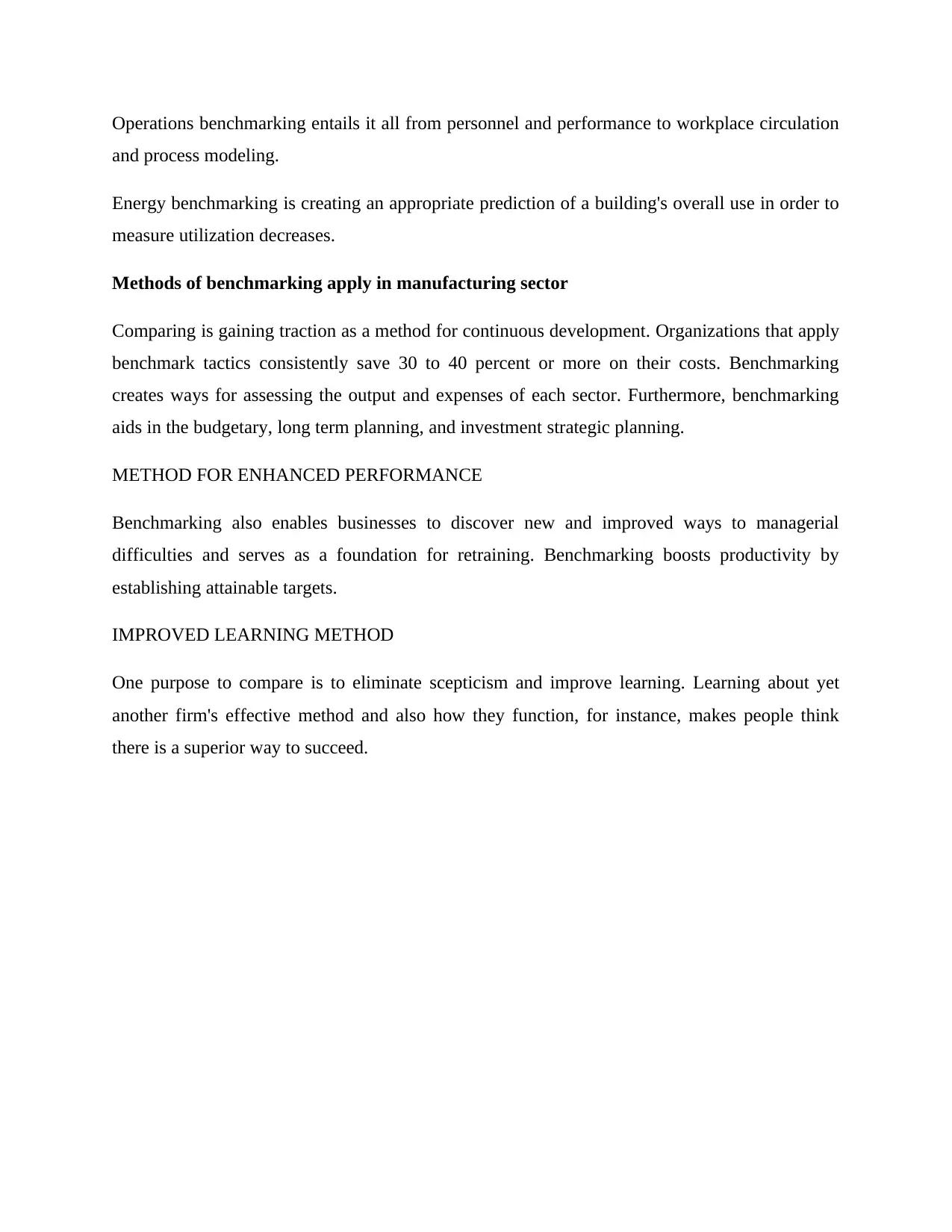
Operations benchmarking entails it all from personnel and performance to workplace circulation
and process modeling.
Energy benchmarking is creating an appropriate prediction of a building's overall use in order to
measure utilization decreases.
Methods of benchmarking apply in manufacturing sector
Comparing is gaining traction as a method for continuous development. Organizations that apply
benchmark tactics consistently save 30 to 40 percent or more on their costs. Benchmarking
creates ways for assessing the output and expenses of each sector. Furthermore, benchmarking
aids in the budgetary, long term planning, and investment strategic planning.
METHOD FOR ENHANCED PERFORMANCE
Benchmarking also enables businesses to discover new and improved ways to managerial
difficulties and serves as a foundation for retraining. Benchmarking boosts productivity by
establishing attainable targets.
IMPROVED LEARNING METHOD
One purpose to compare is to eliminate scepticism and improve learning. Learning about yet
another firm's effective method and also how they function, for instance, makes people think
there is a superior way to succeed.
and process modeling.
Energy benchmarking is creating an appropriate prediction of a building's overall use in order to
measure utilization decreases.
Methods of benchmarking apply in manufacturing sector
Comparing is gaining traction as a method for continuous development. Organizations that apply
benchmark tactics consistently save 30 to 40 percent or more on their costs. Benchmarking
creates ways for assessing the output and expenses of each sector. Furthermore, benchmarking
aids in the budgetary, long term planning, and investment strategic planning.
METHOD FOR ENHANCED PERFORMANCE
Benchmarking also enables businesses to discover new and improved ways to managerial
difficulties and serves as a foundation for retraining. Benchmarking boosts productivity by
establishing attainable targets.
IMPROVED LEARNING METHOD
One purpose to compare is to eliminate scepticism and improve learning. Learning about yet
another firm's effective method and also how they function, for instance, makes people think
there is a superior way to succeed.
⊘ This is a preview!⊘
Do you want full access?
Subscribe today to unlock all pages.

Trusted by 1+ million students worldwide
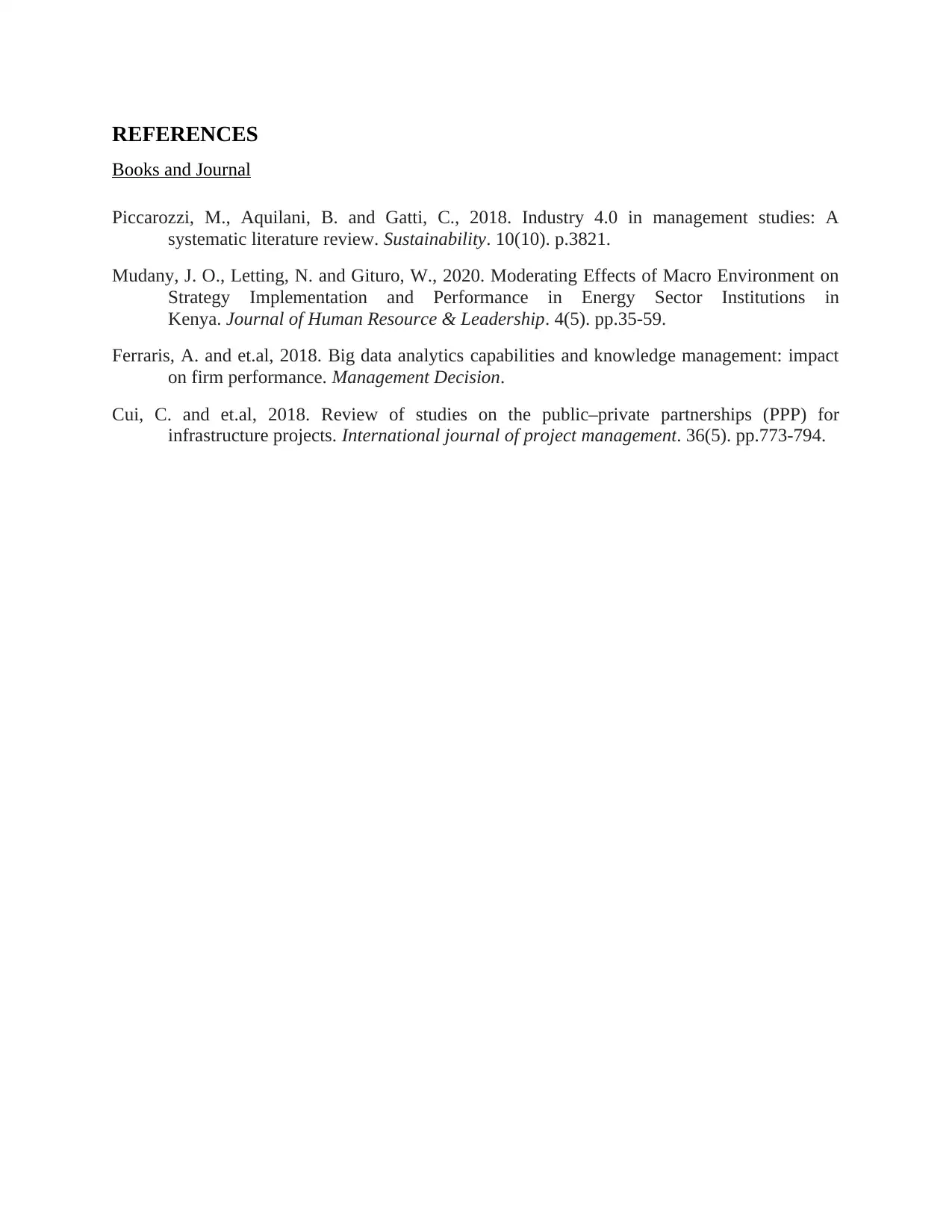
REFERENCES
Books and Journal
Piccarozzi, M., Aquilani, B. and Gatti, C., 2018. Industry 4.0 in management studies: A
systematic literature review. Sustainability. 10(10). p.3821.
Mudany, J. O., Letting, N. and Gituro, W., 2020. Moderating Effects of Macro Environment on
Strategy Implementation and Performance in Energy Sector Institutions in
Kenya. Journal of Human Resource & Leadership. 4(5). pp.35-59.
Ferraris, A. and et.al, 2018. Big data analytics capabilities and knowledge management: impact
on firm performance. Management Decision.
Cui, C. and et.al, 2018. Review of studies on the public–private partnerships (PPP) for
infrastructure projects. International journal of project management. 36(5). pp.773-794.
Books and Journal
Piccarozzi, M., Aquilani, B. and Gatti, C., 2018. Industry 4.0 in management studies: A
systematic literature review. Sustainability. 10(10). p.3821.
Mudany, J. O., Letting, N. and Gituro, W., 2020. Moderating Effects of Macro Environment on
Strategy Implementation and Performance in Energy Sector Institutions in
Kenya. Journal of Human Resource & Leadership. 4(5). pp.35-59.
Ferraris, A. and et.al, 2018. Big data analytics capabilities and knowledge management: impact
on firm performance. Management Decision.
Cui, C. and et.al, 2018. Review of studies on the public–private partnerships (PPP) for
infrastructure projects. International journal of project management. 36(5). pp.773-794.
1 out of 7
Your All-in-One AI-Powered Toolkit for Academic Success.
+13062052269
info@desklib.com
Available 24*7 on WhatsApp / Email
![[object Object]](/_next/static/media/star-bottom.7253800d.svg)
Unlock your academic potential
Copyright © 2020–2025 A2Z Services. All Rights Reserved. Developed and managed by ZUCOL.


